Your digestive system is made up of several organs that work together
to break your food down into its simplest parts. One way to think about
the digestive system is like an assembly line in a factory, but instead
of something being put together, it’s being taken apart.
Once you chew and swallow your food, it takes off on a trip through
your oesophagus, stomach, small and large intestine, pancreas, gallbladder,
and liver. In the process, your body absorbs important vitamins, carbohydrates,
minerals, fats and proteins. It can take hours or days for the food
to complete its journey.
It begins with the oesophagus. The oesophagus is about 25 centimetres
long and moves food from the back of your throat down to your stomach.
It takes about two to three seconds for the muscles in the oesophagus
to move the food along.
Your stomach is the tub at the end of the tunnel. It’s a stretchy
sack shaped like the letter J and works like a big blender in your
belly. The stomach stores and breaks down the food you’ve eaten
into a liquid mixture, which is slowly emptied into your small intestine.
How anyone can call an organ that measures three to five centimetres
around and 6.7 metres in length small is a mystery. The small intestine
is packed underneath your stomach and uses the liver, pancreas and
gallbladder to break your food down even further. The small intestine
sucks most of the vitamins, minerals, proteins, carbohydrates and fat
out of your food. It takes your food more than four hours to work its
way through. By the end of the journey, some of the nutrients have
made their way to the liver and the leftovers move on to the large
intestine.
The large intestine is about seven to 10 centimetres around and 1.5
metres long. This organ takes all the stuff your body can’t use
and flushes it out of your body. Your body gets one last chance to
absorb water, minerals and nutrients from this last bit of stuff when
it passes through the large intestine, also called the colon. After
the colon has absorbed all the goodness it can, the stuff hardens and
is moved to the rectum, where it waits for you to go to the toilet.
So there you are, sitting at lunch, enjoying some grilled chicken pizza
and a few orange wedges. When you're finished, you take a last drink
of milk, wipe your mouth, and head back to work. In a few minutes you're
thinking about going to the gym after work or what’s on telly
tonight You've completely forgotten about that pizza lunch you just
ate. But it's still in your stomach - sort of like a science experiment
that happens all the time!
Your digestive (say: dye-jes-tiv) system started working even before
you took the first bite of your pizza. And the digestive system will
be busy at work on your chewed-up lunch for the next few hours - or
sometimes days - depending upon what you've eaten.
This process, called
digestion, allows your body to get the nutrients and energy it needs
from the food you eat. So let's find out what's happening to that pizza,
orange, and milk.
The Mouth Starts Everything Moving
Even before you eat, when you smell a tasty food, see it, or think
about it, digestion begins. Saliva (say: suh-lye-vuh), or spit, begins
to form in your mouth. When you do eat, the saliva breaks down the
chemicals in the food a bit, which helps make the food mushy and easy
to swallow. Your tongue helps out, pushing the food around while you
chew with your teeth. When you're ready to swallow, the tongue pushes
a tiny bit of mushed-up food called a bolus (say: bow-lus) toward the
back of your throat and into the opening of your esophagus, the second
part of the digestive tract.
The esophagus (say: ih-sah-fuh-gus) is like a stretchy pipe that's
about 10 inches (25 centimeters) long. It moves food from the back
of your throat to your stomach. But also at the back of your throat
is your windpipe, which allows air to come in and out of your body.
When you swallow a small ball of mushed-up food or liquids, a special
flap called the epiglottis (say: eh-pih-glah-tiss) flops down over
the opening of your windpipe to make sure the food enters the esophagus
and not the windpipe.
If you've ever drunk something too fast, started to cough, and heard
someone say that your drink "went down the wrong way," the
person meant that it went down your windpipe by mistake. This happens
when the epiglottis doesn't have enough time to flop down, and you
cough involuntarily (without thinking about it) to clear your windpipe.
Once food has entered the esophagus, it doesn't just drop right into
your stomach. Instead, muscles in the walls of the esophagus move in
a wavy way to slowly squeeze the food through the esophagus. This takes
about 2 or 3 seconds.
See You in the Stomach
Your stomach is attached to the end of the esophagus. It's a stretchy
sack shaped like the letter J. It has three important jobs:
to store the food you've eaten
to break down the food into a liquidy mixture
to slowly empty that liquidy mixture into the small intestine
The stomach is like a mixer, churning and mashing together all the
small balls of food that came down the esophagus into smaller and smaller
pieces. It does this with help from the strong muscles in the walls
of the stomach and gastric (say: gas-trik) juices that also come from
the stomach's walls. In addition to breaking down food, gastric juices
also help kill bacteria that might be in the eaten food.
Onward to the small intestine!
22 Feet Isn't Small at All
The small intestine (say: in-tes-tin) is a long tube that's about 1
1/2 inches to 2 inches (about 3.5 to 5 centimeters) around, and it's
packed inside you beneath your stomach. If you stretched out an adult's
small intestine, it would be about 22 feet long (6.7 meters) - that's
like 22 notebooks lined up end to end, all in a row!
The small intestine breaks down the food mixture even more so your
body can absorb all the vitamins, minerals, proteins, carbohydrates,
and fats. The chicken on your pizza is full of proteins - and a little
fat - and the small intestine can help extract them - with a little
help from three friends: the pancreas (say: pan-kree-us), liver, and
gallbladder.
Those organs send different juices to the first part of the small intestine.
These juices help to digest food and allow the body to absorb nutrients.
The pancreas makes juices that help the body digest fats and protein.
A juice from the liver called bile helps to absorb fats into the bloodstream.
And the gallbladder serves as a warehouse for bile, storing it until
the body needs it.
Your food may spend as long as 4 hours in the small intestine and will
become a very thin, watery mixture. It's time well spent because, at
the end of the journey, the nutrients from your pizza, orange, and
milk can pass from the intestine into the blood. Once in the blood,
your body is closer to benefiting from the complex carbohydrates in
the pizza crust, the vitamin C in your orange, the protein in the chicken,
and the calcium in your milk.
Next stop for these nutrients: the liver! And the leftover waste -
remnants of the food that your body can't use - goes on to the large
intestine.
Love Your Liver
The nutrient-rich blood comes directly to the liver for processing.
The liver filters out harmful substances or wastes, turning some of
the waste into more bile. The liver even helps figure out how many
nutrients will go to the rest of the body, and how many will stay behind
in storage. For example, the liver stores certain vitamins and a type
of sugar your body uses for energy.
That's One Large Intestine
At 3 or 4 inches around (about 7 to 10 centimeters), the large intestine
is fatter than the small intestine and it's almost the last stop on
the digestive tract. Like the small intestine, it is packed into the
body, and would measure 5 feet (about 1.5 meters) long if you spread
it out.
The large intestine has a tiny tube with a closed end coming off it
called the appendix (say: uh-pen-dix). It's part of the digestive tract,
but it doesn't seem to do anything, though it can cause big problems,
because it sometimes gets infected and needs to be removed.
Like we mentioned, after most of the nutrients are removed from the
food mixture, there is waste left over - stuff your body can't use.
This stuff needs to be passed out of the body. Can you guess where
it ends up? Well, here's a hint: It goes out with a flush.
Before it goes, it passes through the part of the large intestine called
the colon (say: coh-lun), which is where the body gets its last chance
to absorb the water and some minerals into the blood. As the water
leaves the waste product, what's left gets harder and harder as it
keeps moving along, until it becomes a solid. Yep, it's poo (also called
stool or a bowel movement).
The large intestine pushes the poo into the rectum (say: rek-tum),
the very last stop on the digestive tract. The solid waste stays here
until you are ready to go to the bathroom. When you go to the bathroom,
you are getting rid of this solid waste by pushing it through the anus
(say: ay-nus). There's the flush we were talking about!
Dig That Digestive System!
You can help your digestive system by drinking water and eating a healthy
diet that includes foods rich in fiber. High-fiber foods, like fruits,
vegetables, and whole grains, make it easier for poo to pass through
your system. The digestive system is a pretty important part of your
body. Without it, you couldn't get the nutrients you need to grow properly
and stay healthy. And next time you sit down to lunch, you'll know
where your food goes - from start to finish!
What is Poo?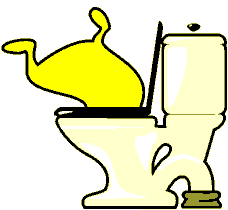
Whenever you eat food, your body takes out all the
good things that it needs to grow, learn and play. Even if you eat
a really healthy diet, your body will not need all of the things you
eat. All of the bad things and the things it doesn't need are formed
into poo. This poo then leaves your body from your bum!
Poo is mostly made from water, but you can't drink it! More than half
of your poo is made from water. The longer your poo stays in your body,
the less water it will have, since your body absorbs the water from
the poo. If it stays for too long it will become harder and difficult
to push out. It is important to try and go for a poo when you feel
you need to.
Other than water, your poo also contains solid material. A lot of
it is bacteria that your body uses to help digest the food. It also
contains fats and other material that your body is getting rid of.
The poo also contains 'fibre'. Fibre helps the poo to travel easily
through your body. The fibre comes from types of food that you have
eaten, such as fruit, vegetables, good quality bread and cereals.
Even though poo started off as food, you must not eat it. The bacteria
and other things in poo can make you very poorly if you eat them. It
also doesn't taste very nice!
Remember: Good healthy food, makes a good healthy poo!
How's My Stool or Poo?
Stools or Poos come in a range of colours. All shades of brown and
even green are considered normal. Only rarely does stool colour indicate
a potentially
serious intestinal condition.
Stool colour is generally influenced by what you eat as well as by
the amount of bile, (a yellow-green fluid that helps digest fats) in
your stool.
As bile pigments travel through your gastrointestinal tract, they
are chemically altered by enzymes — changing the pigments from
green to brown.
Consult your doctor if you're concerned about your stool / poo colour.
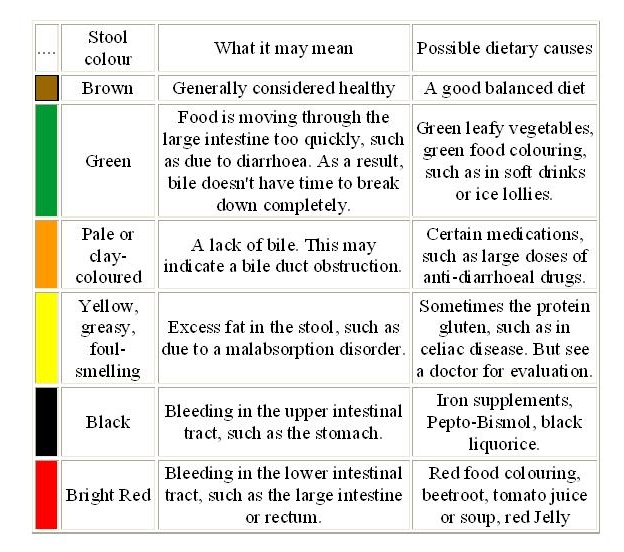
Mucus in stools is generally not an indication of a serious problem.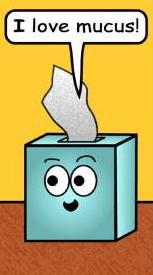
Stool
normally contains a small amount of mucus — a jelly-like substance
that your intestines make to keep the lining of your colon moist and lubricated.
Increased amounts of mucus in your stool may occur with diarrhea or constipation.
However, if you notice a change in your bowel habits or increased mucus in
your stool that lasts for more than a few weeks, or if you have rectal bleeding
or blood in your stool, consult your doctor. These may be signs of an underlying
medical condition that requires evaluation.
What about size and shape?
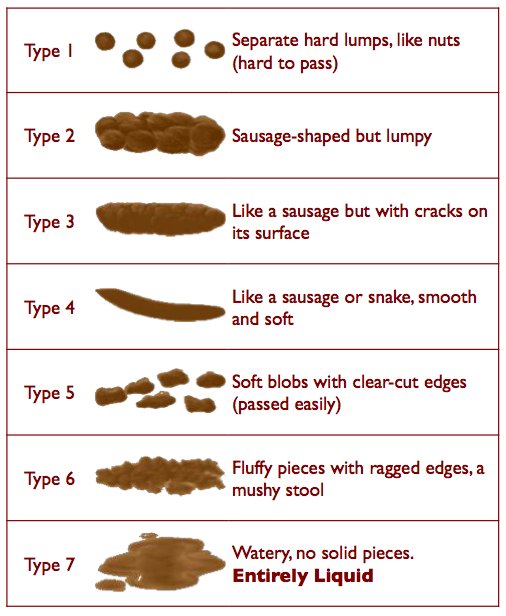
The Bristol Stool Scale or Bristol Stool Chart is
a medical aid designed to classify the feces form into seven groups.
It was developed by Heaton and Lewis at the University of Bristol
and was first published in the Scandinavian Journal of Gastroenterology
in 1997. The form of the stool depends on the time it spends in the
colon.
The seven types of stool are:
Type 1: Separate hard lumps, like nuts or rabbit droppings (hard
to pass).
Type 2: Sausage-shaped, but lumpy
Type 3: Like a sausage but with cracks on its surface
Type 4: Like a sausage or snake, smooth and soft
Type 5: Soft blobs with clear cut edges (easily passed)
Type 6: Fluffy pieces with ragged edges, a mushy stool
Type 7: Watery, no solid pieces (entirely liquid)
Types 1 and 2 indicate constipation.
Types 3 and (especially) 4 are the preferred types of stools as they
are the easiest to pass.
Types 5-6 are more symptomatic of diarrhea, while type 7 may be a
sign of cholera or other illness.
For most individuals eating a Western-type diet, normal daily stool
weight ranges between 100 and 200 grams. Normal bowel frequency ranges
from 3 times a day to 3 times a week. Please note, the term "normal" should
not be confused the term "healthy"
Why Does Poo Smell?
Poo certainly is very smelly. Some poo smells worse than others.
Poo smells due to the work of bacteria in your tummy. 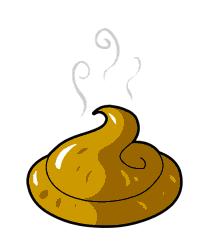
The bacteria
change your food into various compounds and gasses that make it smell
like poo.
If you eat lots of meat, or only meat, then your poo will
smell really bad.
Animals that only eat meat have very smelly poo.
The bacteria in your tummy make a smelly gas called Hydrogen Sulfide.
On its own it smells like rotten eggs. A mixture of things make your
poo smell the way it does.
One of the chemicals in poo that make it smell is called Skatole.
This chemical is also used in some perfumes and even as a flavouring
in ice cream! Yuk!
Fairview
Therapy Clinic Limited
The Annex
28 Brunswick Square
Gloucester
GL1 1UN
Location
Map
01452 521777
Email
Mandy Parker

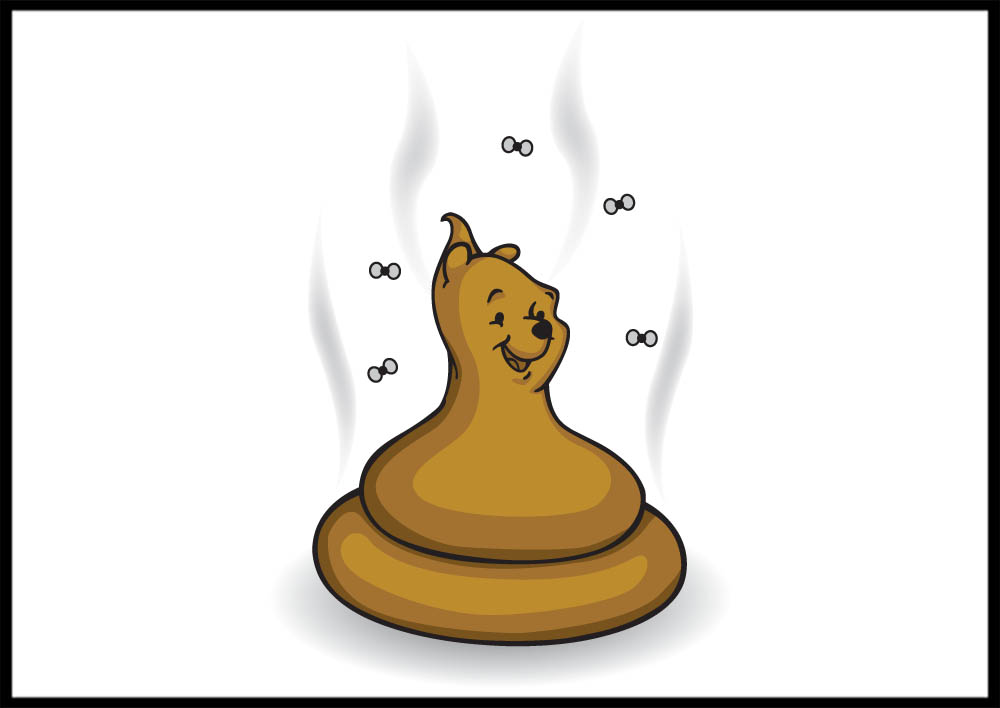 And Poo!
And Poo! 
